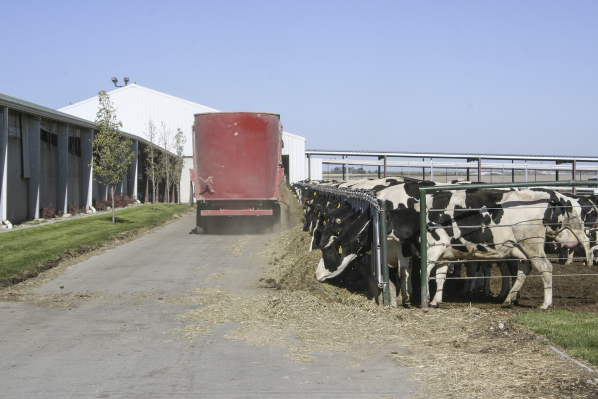One of the truly amazing things about feeding the dairy cow is the diverse nature of the ingredients that can be used in developing the feeding program. While we commonly think in terms of silages, hays, corn, soybean meal and byproducts such as dry distillers grains (DDG) or corn gluten feed, there are a wide range of other ingredients that can be cost-effective and support performance.
One group of ingredients is liquids of many types. Liquid ingredients are, generally, not as well understood as dry ingredients and have not been as well researched. Much recent research has focused on sugar use in lactation ration as a source of rapidly fermented carbohydrates.
One of the most basic liquid ingredients is cane or beet molasses. Both are excellent sources of sugar (both types possessing around 65% sugar, DMB). Other liquids, almost all of which are byproducts, are lower in sugar but contain other nutrients that can be utilized when designing dairy diets.
Many producers and even nutritionists over the years have shied away from using liquids because of the perception that liquids are low in dry matter (DM) and can hurt dry matter intake (DMI). Whey has been fed on-farm as part of the TMR for years. It commonly is very low in DM, on some cases as low as 5% DM. Cane molasses, on the other hand, is generally relatively high in DM, 75% or more in some cases. So liquids can have quite a wide range of DM content as well as other nutrients.
There are numerous factors which facilitate the use of various liquid ingredients and their potential inclusion in dairy diets.
1. Research showing the need for the various nutrients in dairy diets.
2. Increased production and availability of liquid byproducts from other industries.
Byproducts include but are not limited to:
- Cane or beet molasses – byproducts of the sugar industry
- Corn steepwater – a byproduct of corn sweetener production
- Whey – a byproduct of cheese production
- Condensed molasses fermentation solubles – alcohol, whiskey, rum, yeast, some pharmaceuticals, etc.
- Condensed brewers solubles – a byproduct from beer brewing
- Corn or milo distillers solubles – alcohol/ethanol
- Lignin sulfonate – a byproduct of the paper milling industry (Commonly used in the pellet binding process)
These byproducts could once be obtained relatively cheaply. This is not quite as much the case anymore, as nutritionists have been able to identify the true value of the nutrients in each ingredient.
3. Research into a multitude of ingredients which illustrates usefulness in cattle feeds when properly handled. Such ingredients include phosphoric acid, ammonium poly-phosphate, fat products, feather meal, blood meal (non-ruminant), glycerol, propylene glycol and others.
4. Technological advancements in the feed industry. Such advancements include suspension capabilities which allow for the use of non-soluble ingredients such as limestone or feather meal. Ingredients such as these would tend to settle out of a conventional liquid. By using emulsifiers and suspending agents such as attapulgite clay or xantham gum, it is possible to hold these insoluble products within the liquid for extended periods of time.
5. Development of technologies to enhance the shelf life and durability of these products under a variety of conditions including extreme heat and cold.
Through the acceptance and implementation of these factors, current liquid feed products have become highly technical, value-added products. When properly fed as a supplement, liquid feeds can effectively provide for most of the nutrient needs of the cow or growing calf on hay or pasture.
So which products work, which do not?
Virtually any liquid ingredient can find a home in the TMR as long as the product is understood and accurate analyses are available. In many cases, liquids such as whey or even water have been added directly to the TMR to add moisture and palatability, subsequently improving DMI. In other cases, further palatability can be applied by adding ingredients such as molasses or cornsteep water, both of which are very palatable (pleasant aroma).
Another benefit is: These highly palatable ingredients can help mask changes in the TMR. This may include silage sources, feed ingredients, etc., all of which can alter the smell or taste of the TMR to the cow and might otherwise reduce DM intake.
Virtually any of the liquid ingredients can work once nutrients, levels, digestibility and costs are understood. These can be formulated in like any other ingredient and are ultimately used based on cost-effectiveness and their ability to support and promote milk production, components, reproduction and health.
Some liquid ingredients can and have been fed as commodities. Whey or different iterations of whey have been added and fed independently for years. As discussed, in many cases whey has been fed largely for the moisture contribution, although it does carry low amounts of other nutrients. Some versions, for instance fermented, ammoniated condensed whey (FACW), contains a considerably higher crude protein content, mostly from non-protein nitrogen, as well as a high lactic acid content. Feeding to transition cows has been shown to reduce the incidence of subclinical acidosis. Ingredients such as corn steepwater are higher in protein (considered largely soluble) and phosphorus. Steepwater is moderate in DM and highly palatable.
Like any byproduct, liquid ingredients by themselves can be somewhat variable from load to load. Remember, these are byproducts and are produced as a result of producing something more valuable. While there may be some out there that are still very low-cost, most byproducts have been recognized for their nutrient values and are sold in relation to that value.
Manufactured products and supplements
There are limitless combinations that can be created with liquid ingredients. This will depend on the capability of the manufacturer and inventories of a given liquid plant. Depending on the company and facility, they can produce anything from very simple blends (two or three ingredients) up to very technical supplements delivering a variety of ingredients, supplemental nutrients and additives. It also depends on the ability of the nutritionist to develop the correct combination of ingredients, just as a dry supplement might be formulated to fit a particular ration.
A significant criterion in using liquid versus dry premixes relates to the cost of delivering these nutrients, supplements and additives in liquid form. As mentioned earlier, storage and handling of liquids is generally cheaper and simpler than dry materials and, if structured properly, will blend more uniformly in the TMR. But as with everything, there are pros and cons. Some of these include:
Pros
- Liquid supplements can be formulated and manufactured to handle a very wide variety of ingredients, nutrients, supplements and additives.
- Storage tanks (steel or poly/plastic) are simple, relatively inexpensive and easy to set up and plumb in.
- Requires fairly powerful motor and pump to move product into and out of the tank (onto TMR). The actual size of the pumping system will depend on the type of product being used. Heavier, more viscous products will require bigger, more powerful pumping systems.
- If the application systems are properly designed (a fairly simple process), incorporation into the mix and total mix consistency is very good. The result is better TMR consistency and better feeding quality.
Cons
- Some nutrients are limited in inclusion. Very heavy, dense ingredients such as calcium or magnesium (Mag Ox) are limited in inclusion rates. However, this can be compensated by total amount of liquid supplement added.
- Liquid supplements are subject to the effects of cold weather. As temperatures drop, viscosity increases and pumping becomes more difficult. Locations in areas where it can get colder will need to add heating as well as some insulation to tanks.
- Tanks using ingredients that may have a tendency to settle out, fats, suspensions, etc., should include plumbing that allows for recirculation/mixing of the product periodically to ensure mix. This will increase the cost of storage and handling.
Use of liquid ingredients and supplements can be very useful and cost-effective. As discussed, there are a wide variety of ingredients that can be used for liquid supplement formulations, and an understanding of the nutrients and effects in the cow are important.






